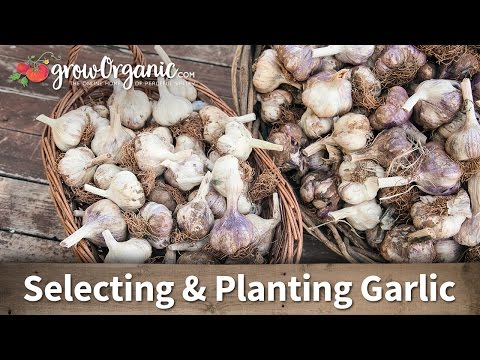Item Number: FP551
Elephant Garlic (Lb)
Mild Garlic Flavor That's A Great Keeper
- They call it Elephant because it gets so big!
- It looks, smells, and tastes like garlic but it's actually a member of the leek family.
- Cure for 30 days before using, or it will be bitter.
- Raw flavor is like an intense green onion with a garlic taste, but we recommend using this cooked, not raw.
- Delicious in chicken dishes, or as an onion or leek substitute in soups or stews.
- A great keeper, storing up to a year.
- Grows best where winters aren't too severe (sorry, Midwesterners).
- When raised in optimal conditions, this monster can be 4" across.
- Packaged as a combination of bulbs and individual cloves by weight.
- Approximately 1.5–2 bulbs per pound, 5–6 cloves per bulb.
- Grown in California
Welcome to the world of growing elephant garlic, a unique member of the allium family renowned for its mild yet flavorful bulbs. In this guide, we'll explore everything you need to know about cultivating elephant garlic, from planting to harvest, and offer valuable tips for optimal growth.
Understanding Elephant Garlic
Elephant garlic (Allium ampeloprasum var. ampeloprasum) is often mistaken for regular garlic due to its appearance and taste. However, it belongs to the leek family and produces large, mild-flavored bulbs.
These bulbs, resembling oversized garlic cloves, offer a mild garlic flavor with hints of onion and leek. They are best enjoyed cooked rather than raw.
Climate and Soil Requirements
Elephant garlic thrives in regions with mild winters and cool summers. It prefers well-drained soil with good fertility and a pH level between 6.0 and 7.0.
While it can tolerate various soil types, loamy soil enriched with organic matter is ideal for optimal growth.
It thrives in various soil types, including clay soil and sandy soil, making it adaptable to different garden environments. Its tolerance for sand, silt, and clay ensures successful growth for gardeners facing diverse soil compositions. With its easy-to-grow nature and preference for full sun, it is an excellent choice for gardeners seeking a low-maintenance, sun-loving plant for their garden beds or containers.
Planting Elephant Garlic
Plant elephant garlic cloves in the fall, approximately 2–4 weeks before the first frost date. This allows the cloves to establish roots before winter dormancy.
Choose large, healthy cloves for planting, ensuring they are firm and free from disease or damage.
Space the cloves 6–8 inches apart in rows with 12–18 inches between rows. Plant the cloves 2 inches deep with the pointed end facing up.
During the growing season, this garlic develops robust plant roots, anchoring itself securely in the soil. To promote healthy growth, ensure good drainage to prevent waterlogging, which can hinder root development. Planting individual cloves at the proper depth allows for optimal root establishment, setting the stage for a successful harvest of large, flavorful bulbs.
Care and Maintenance
Water the garlic regularly, keeping the soil consistently moist but not waterlogged. Reduce watering as the bulbs mature to prevent rot.
Mulch around the plants to conserve moisture, suppress weeds, and regulate soil temperature.
Fertilize the garlic with a balanced fertilizer high in nitrogen during the early stages of growth. Avoid excessive nitrogen as it can promote leafy growth at the expense of bulb development.
Flavor and Aroma Profile
-
Flavor Profile: It offers a mild and subtly sweet flavor, significantly less pungent than true garlic varieties. Its flavor leans more toward that of a leek or onion, making it a versatile choice for those who prefer a gentler garlic presence in their dishes. When roasted or cooked, it develops a creamy, buttery quality with nutty undertones, ideal for spreads, soups, or mellow garlic accents in gourmet cuisine.
-
Aroma Profile: The aroma of this garlic is delicate and mellow, lacking the sharp pungency associated with traditional garlic. When raw, it emits a faint onion-like scent, while cooking brings out a warm, inviting fragrance that complements rather than overwhelms other ingredients in a dish.
Harvesting Elephant Garlic
It typically matures in late spring to early summer, approximately 9–10 months after planting.
Monitor the foliage for signs of yellowing and drying, indicating that the bulbs are ready for harvest.
Carefully loosen the soil around the bulbs with a garden fork and gently lift them from the ground. Avoid damaging the bulbs during harvest to ensure optimal storage quality.
Storage and Preservation
Best Practices for Drying and Freezing
Freezing this garlic is an excellent way to extend its shelf life while preserving its gentle flavor. You can freeze it as whole cured bulbs, individual cloves (peeled or unpeeled), or pre-chopped, depending on your culinary needs. Although you can freeze fresh, uncured garlic, it’s not typically advised for it due to its high moisture content, which may result in a softer texture and milder taste once thawed. For best results, always cure the garlic first before freezing.
Common Pests and Diseases
While this garlic is relatively resistant to pests and diseases, it may still encounter challenges such as aphids, onion maggots, and fungal infections.
Monitor the plants regularly for signs of pests or disease, and promptly take action to mitigate any issues. Practices such as crop rotation and proper sanitation can help prevent problems.
Tips for Success
Plant elephant garlic in raised beds or containers if your soil is heavy or poorly drained.
Avoid overwatering, especially during the dormant period, as it can lead to rot and fungal diseases.
Consider companion planting with crops such as tomatoes, lettuce, or peas to maximize garden space and deter pests.
Why Order From Us?
We proudly offer premium Elephant Garlic, grown by trusted California farmers and selected for size, quality, and vigor. This mild-flavored giant is ideal for fall planting and performs best in regions with mild winters. Each bulb is carefully handled to ensure excellent germination and robust growth, making it a great choice for gardeners seeking an easy-to-grow and flavorful addition to their edible landscape. Sold by the pound, it is perfect for roasting, sautéing, or as a mild substitute for leeks and onions.
Explore our full range of hardneck seed garlic varieties and softneck seed garlic varieties to diversify your garden with exceptional flavors and dependable harvests.
Please note: It will look different than other varieties of garlic on arrival. The cloves may have separated from the bulb and the papery skins may be peeling. This is completely normal and will not affect viability.
** For more information, see our Garlic Resource Center and try out our Garlic Selector Tool to find the perfect garlic for your growing zone and tastes. Or check out all of our Garlic Learning Blogs where our staff have selected dozens of articles, videos, recipes and tips to help you learn how to successfully grow garlic bulbs.**




Check Your Zone Compatibility:
Compatible with your zone.
Growing Zone for

Our Guarantee To You
Since 1976, we've served our customers at every stage of growing. Please contact us at any time. We are happy to support and assist you.
Shipping Information
Shipping Information
We cannot delay ship garlic/shallots. They will be shipped as soon as they are in stock.
Cannot ship to the following states: HI, ID, PR, GU, VI
Shipping Weight: 1.1 lb
Dimensions: 5.0"L x 3.0"W x 3.0"H
Features
Features
- Bulb
- Mild Flavor
- WSDA Certified Organic
Characteristics
Characteristics
Planting & Care
Planting & Care
Useful Information
Useful Information
Guarantee
Guarantee
Limited Seed Garlic Guarantee (When Planted by November 15th)
Claim Deadline is 45 Days from Purchase or Delivery. (Claims placed after December 31st will be denied.)
What We Guarantee
Our only guarantee is that the seed garlic we sell will germinate, provided you follow the steps listed in our Garlic Planting & Growing Guide. This guarantee is only available to customers who purchase their seed garlic directly from us.
What We Cannot Guarantee
We cannot guarantee that your garlic will remain alive & healthy, or sizes up properly, as there are too many variables beyond our control to be able to do so (i.e. soil preparation, fertilization, weed and pest control, temperature control, irrigation, etc).
How to Request a Credit
If you encounter a significant lack of germination of your garlic (over 50%), please contact us within 45 days of delivery. If we determine that your garlic had a significant lack of germination, we will issue you a credit (not a refund) for the purchase price of your garlic (excluding shipping).* This 45-day time frame is meant to allow you up to 2 weeks to plant your garlic, and up to 4 weeks to check for signs of growth.
(*) We reserve the right to not issue credit for items already replaced. We also reserve the right to require photographic evidence of the lack of germination of your garlic.
Share





Showed up in perfect condition. There were a handful that were small but overall they all were in good shape.
First time trying elephant garlic and very happy with Grow Organic's supply! Healthy, firm and reading for planting. Also, had to taste some and it is quite delicious. Looking forward to a healthy harvest next Spring/Summer.
Have to add that Customer Service was great, very helpful and quick to respond. Many thanks. Will definitely buy from Grow Organic again!
Came in individual cloves and all healthy. 90 percent were large and perfect seed stock with a few smaller ones. Couldn’t be happier
I purchased Elephant and Music garlic bulbs to plant in my zone 7 garden. They arrived as firm, healthy bulbs.











